Papers by Solomon Sola Gabriel

Tropical Life Sciences Research
The body characteristics and yield indices of Clarias gariepinus, Bagrus bajad, Synodontis nigrit... more The body characteristics and yield indices of Clarias gariepinus, Bagrus bajad, Synodontis nigrita, Labeo senegalensis and Mormyrus rume from lower Benue River in Nigeria were determined in this study using 60 samples each for the fish species. Length, weight and fillet correlations were also determined during the study. Results obtained showed that M. rume, L. senegalensis and C. gariepinus had the highest percentage of edible parts (≥ 55%) compared to the other species (≤ 39%). Concerning correlations of the fillet with the morphological variables, results obtained suggest that fillet yield is independent of fish size (except for C. gariepinus which was positively correlated). Also, only samples of L. senegalensis showed isometric growth pattern; the other fish species had either positive (C. gariepinus and B. bajad) or negative (S. nigrita and M. rume) allometric growth. While the difference in fillet yield and body characteristics was attributed to the structural anatomy and oth...

Banat's Journal of Biotechnology, 2013
This study seeks to compare the growth of two African catfishes and their hybrid fed with commerc... more This study seeks to compare the growth of two African catfishes and their hybrid fed with commercial diet. Fingerling of Clarias gariepinus Heterobranchus bidorsalis and hybrid H. bidorsalis x C. gariepinus (Heteroclarias) were obtained from homogeneous breeding. Fingerlings with mean weight 1.110.01 were stocked in triplicate plastic tanks for this study. The study observed that C. gariepinus had the highest Mean Final weight (7.75), Mean weight gain (6.65), Specific growth rate (2.10), Feed conversion efficiency (53.2 %) and Protein efficiency ratio (6.23) compared with H. bidorsalis and Heteroclarias which had lower growth values (p<0.05), however survival rate were the same across the species. Similarly carcass moisture and lipid content were observed to be higher in C. gariepinus compared to the others, However, Ash, fiber and NFE content of the hybrid were higher compared to pure breeds (P<0.05). Also, significantly higher carcass protein was recorded in H. bidorsalis compared to the others, while higher lipid where observed in C. gariepinus. It is concluded that at early stage of life, C. gariepinus exhibit faster growth rate.

Jordan Journal of Agricultural Sciences
This study was conducted to determine fish composition and diversity Index in Lake Kalgwai Jigawa... more This study was conducted to determine fish composition and diversity Index in Lake Kalgwai Jigawa State, Nigeria between July 2012 and April 2013. The ichthyofauna of Lake Kalgwai was assessed using catches statistics at three major landing sites of the Lake, namely Marke, Dingare and Kalgwai. Twenty-seven fish species belonging to sixteen families were encountered during the study period. Fish species of Cichlidae, Bagridae, and Mormyridae were found dominant representing 13.8%, 13.4% and 12.6% of the total catch, respectively. Citharinidae was the least abundant (0.53%). Eight species were found numerically dominant in the catch based on the monthly generated data. It include Lates niloticus (11.1%), Oreochromis niloticus (11.1%), Mormyrus macrophthalmus (9.8%), Synodontis nigrita (8.4%), Bagrus bayad (8.4%), Heterotis niloticus (7.6%), Malapterurus electricus (7.5%%), and Clarias gariepinus (7.0%). Fish diversity indices estimated included species richness (d) which ranged from 0.94 (March) to 1.93 (October), Shannon – Wiener index (H’) between 0.22 (January) to 1.60 (July), Equitability Index (J) ranging from 0.10 in January to 0.89 in July, Simpson’s Index (D) from 0.14 (October) to 0.23 (July) and Species Heterogeneity (1 – D) from 0.77 (September) to 0.86 (October). It was concluded that there was high fish species richness in the Lake. Also, species equitability index of fishes across all the landing sites reveals that the distribution of species or fish population is nearly even.
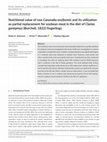
The nutritional value of raw Jack bean meal (Canavalia ensiformis) as a partial substitute for so... more The nutritional value of raw Jack bean meal (Canavalia ensiformis) as a partial substitute for soybeans meal was investigated in this study. Preliminary investigation on nutrient composition revealed that lysine, histidine, and phenylalanine were significantly higher in C. ensiformis seed meal compared to soybean meal. However, crude protein and other essential amino acids were significantly lower. Feeding trial was then conducted to investigate the effect of replacing about 40% soybeans meal (at 58.8% inclusion) with C. ensiformis in the diet of Clarias gariepinus. The result obtained after 56 days revealed that fingerlings could tolerate up to 20% replacement without significant effect on growth and nutrient utilization. Beyond this, growth was significantly reduced. Survivals of the fish also follow a similar trend as stated above. It was concluded that dietary inclusion of raw C. ensiform meal should not be beyond 11% (or 20% replacement for soybeans meal included at 58.8%) in t...

This study investigated the catch per unit effort and water quality of Lake Kalgwai Jigawa state,... more This study investigated the catch per unit effort and water quality of Lake Kalgwai Jigawa state, Nigeria for the period of 10 month (July 2012-June 2013). The man hours, gears used, and fish catches of the Lake was determined by assessing the fisher-men operating on three major landing sites of the Lake, namely Marke (Site I), Dingare (Site II), and Kalgwai (Site III). Water samples from the landing sites were collected and analyzed. Concentration of fishers ranged from 41 (April) to 51 (September). The highest number of fishing hour was observed in August (64 hr), whereas the lowest was in March (49 hr). The average catch per fisher per day ranged from 107 kg/day (December) to 144 kg/day (August) during the study period. An average of 25 days was spent fishing in each month. The result also indicated similarities in the water qualities of all the three sampling sites per months. Based on the result gotten it was concluded that lake Kalgwa is not over fished and water quality are within recommended ranges for fish production.
The study seeks to investigate the suitability of sweet potato peel (SPP) as an energy source in ... more The study seeks to investigate the suitability of sweet potato peel (SPP) as an energy source in replacing increasingly expensive conventional Yellow Maize Meal (YMM) in the diet of African catfish fingerlings. Result obtained reveals that SPP can completely replace Maize meal (at 33.35 level of inclusion). However growth parameters were maximum at 16.68 and 25.01 level of inclusion in the diet (i.e., at 50 and 75% substitution level respectively). Carcass of fish fed experimental diets also shows higher protein and lipid content for dietary inclusions of SPP compared to the initial and fish fed the control diet. Use of cassava peels to replace conventional energy source is therefore advice so as to reduce production cost and consequently recycling of waste to wealth at no cost.
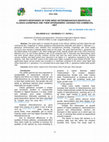
This study seeks to compare the growth of two African catfishes and their hybrid fed with commerc... more This study seeks to compare the growth of two African catfishes and their hybrid fed with commercial diet. Fingerling of Clarias gariepinus Heterobranchus bidorsalis and hybrid H. bidorsalis x C. gariepinus (Heteroclarias) were obtained from homogeneous breeding. Fingerlings with mean weight 1.110.01 were stocked in triplicate plastic tanks for this study. The study observed that C. gariepinus had the highest Mean Final weight (7.75), Mean weight gain (6.65), Specific growth rate (2.10), Feed conversion efficiency (53.2 %) and Protein efficiency ratio (6.23) compared with H. bidorsalis and Heteroclarias which had lower growth values (p<0.05), however survival rate were the same across the species. Similarly carcass moisture and lipid content were observed to be higher in C. gariepinus compared to the others, However, Ash, fiber and NFE content of the hybrid were higher compared to pure breeds (P<0.05). Also, significantly higher carcass protein was recorded in H. bidorsalis compared to the others, while higher lipid where observed in C. gariepinus. It is concluded that at early stage of life, C. gariepinus exhibit faster growth rate.
Starting an aquaculture business in Nigeria requires a good understanding of the industry. Small ... more Starting an aquaculture business in Nigeria requires a good understanding of the industry. Small aquaculture ventures cannot compete effectively in the present scenario where large farms are springing up in the urban areas of Nigeria. The export market for aquaculture products has not been fully exploited. The export of smoked fish to the United Kingdom has been ongoing and is expanding but it is meant to serve the African community in the UK. The bane of the aquaculture industry lies in the small nature of most of the enterprises. Nigeria has no specific legislation on aquaculture hence the idea of a National Aquaculture Strategic Initiative is a welcome development.
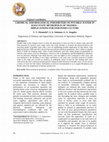
Potable water is the cheapest source of water for aquaculture in areas not close to surface water... more Potable water is the cheapest source of water for aquaculture in areas not close to surface water and with little potential for ground water usage; hence this study attempts to evaluate the physicochemical and microbial quality of potable water with a view of establishing possible implication on fish-culture. Data gathered between 2009 and 2012 showed that most physicochemical parameters where within acceptable limits of WHO for drinking water; value of most parameters were also within ranges recommended for intensive fish-culture, however Phosphorus, Nitrate as well as Manganese and Phenolphthalein Alkalinity were not detected. Although Total viable bacteria count was higher in 2012 compared to other years, and was attributed to the flooding of river Niger and Benue in the same year; microbial analysis of potable water in the study area reveals no tendency of pathogenic threat if used for fish farming (but water collected in the 2012 could post health hazard to human health).Therefore if potable water is to be used as a source of water for fish culture, fertilization is however recommended so as to supply Phosphorus and Nitrate which are integral part of primary productivity.

This study evaluated the physicochemical and microbial water quality as well as abundance of fish... more This study evaluated the physicochemical and microbial water quality as well as abundance of fish fauna in the flooded area of Lokoja Metropolis (Kogi State, Nigeria) resulting from the flooding of the River Niger and River Benue between September and October 2012 due to the release of water from Lagdo Dam in Cameron and Kanji Dam in Nigeria. Physicochemical and microbiological water qualities were determined using standard methods by APHA. Results obtained revealed that water quality deteriorated and fluctuated significantly. Microbial analysis of water from flowing river as well as those from flood plain was moderate in total coliform (0.042x10 5 and 0.45x10 5 respectively), while in residential areas, total coliform levels were critical (3.4x10 5 and 6.8x10 5). The study which recorded 7,518 fishes belonging to 9 families and 13 species indicated relative diversity with the use of various abundance indices. However, Cichlidae dominated (97.79%) the families in the study while Gymnarchidae had the least (0.013%) abundance. Water quality deterioration and lower species diversity in the study area were largely due to the flood.

The aim of the present study was to evaluate the fecundity and hatchability of common carp admini... more The aim of the present study was to evaluate the fecundity and hatchability of common carp administered ovaprim diluted with 0.9% saline water at a ratio of 1:1, 1:2, 1:3, 1:4, 1:5, 1:6, 1:7, 1:8 1:9 and 1:10 with 1:0 serving as the control. The diluted hormones were injected to brood fish at a dose of 0.5 ml kg-1. The study observed that latency period lasted between 8 th and 11 th h after hormonal administration and higher dilution levels delayed striping time compared to the control and the first two dilution levels. Cyprinus carpio did not respond to 1:9 and 1:10 dilutions of ovaprim. Consequently fecundity and hatchability decreased as the level of dilution increases. The optimum dilution of ovaprim to induce ovulation for reducing the cost of hatchery operation in common carp was found 1:5 in 0.9% normal saline. Beyond this dilution, fecundity and hatchability are greatly affected.

Testes quality assessment of African Catfish broodstock was investigated using fifteen male brood... more Testes quality assessment of African Catfish broodstock was investigated using fifteen male broodstocks of Clarias gariepinus with mean weight of 570.8 g + 2.04. Testes were removed and weighed and semen from the testes were released into a petri dish and measured in ml using a plastic syringe. 1:50 dilution ratio with potassium chloride was used as the diluent to facilitate counting of the spermatozoa. The highest sperm count was 9.7 x 1010 spm/ml and the least was 3.8 x 1010 spm/ml, also highest semen volume of 1.3 ml was recorded as against 0.21 ml which was the lowest, percentage motility of the semen varied between 57.1% and 93.7%. Correlation between % motility and sperm count was significant (P = 0.00007 and r = 0.845) which indicates a strong positive correlation between the two parameters. Correlation between weight of testes and volume of semen was also very significant (P = 0.0000 and r = 0.978. Correlation between body weight and weight of testes was significant (P = 0.0049 and r = 0.684) and strongly positive while a significant correlation was observed between volume of semen and the weight of broodstock which was also a strong positive correlation (P = 0.0053 and r = 0.679). Volume of semen can be predicted using: Vol of Semen =-0.219 + 0.000102 Wt. of. Male + 0.356 Wt. of Testes (r2 = 95.7% (Adjusted = 94.9%), P = 0.000) and % Motility can also be predicted from the equation: % Motility = 39.0 + 7.4 Vol of Semen + 9 x10-10 Sperm Count-11.6 Wt. of. Testes (r2 = 79.2% (Adjusted = 73.5%), P = 0.000).

The effect of varied levels of inclusion of Garcinia kola seed meal in diets on growth performanc... more The effect of varied levels of inclusion of Garcinia kola seed meal in diets on growth performance and haematological parameters was investigated in Clarias gariepinus fingerlings. Fish were fed diet supplemented at 0, 50, 100, 150 and 200 g kg-1 inclusion levels of Garcinia kola seed meal for eight weeks. Fish feed supplemented with Garcinia kola meal showed significantly improved growth performance and feed utilization over the control (0 kg-1 Garcinia kola seed meal) treatment. The highest specific growth rate (1.34±0.02% day-1) and best feed conversion ratio (16.28±0.05) were obtained in 100 g kg-1 inclusion level of Garcinia kola seed. Protein efficiency ratio and feed conversion efficiency were also higher in fish fed with Garcinia kola seed meal and lowest in the control. Generally growth decreased beyond 100 g kg-1 level of inclusion. Protein and lipid content increased (p<0.05) in fish supplemented with seed meal. Also there was an improvement in blood parameters (WBC, HGB, RBC, and PCV) in fish fed with Garcinia seed meal compared to the control. The result suggests that dietary supplementation with Garcinia kola seed meal improved growth rate and feed utilization was the best at 100 g kg-1 for Clarias gariepinus fingerlings.
Acute toxicity test involves estimation of LC50 or LD50 which is the concentration or dose which ... more Acute toxicity test involves estimation of LC50 or LD50 which is the concentration or dose which proved to be lethal causing death to 50% of the tested organisms. This article reviews the methods utilized for the determination of probit and LC50 and also explain the use of Minitab 14 statistical package and Microsoft office excel 2007 for accurate, speedy and qualitative presentation of toxicity results. We also present a brief review on the relationship between uptake route of toxicants and their toxic effects.
Nigeria offers the largest market for fisheries products in Africa. Fish production from capture ... more Nigeria offers the largest market for fisheries products in Africa. Fish production from capture fisheries in spite of its being
expensive and risky in the coastal line regions of Nigeria has been erratic and on the decline in recent years, resulting in increase in poverty and nutritional deficiency. Aquaculture production remains the best option to bridge the gap between the total fish demand and total domestic production in the face of high cost of production input and unstable government policy. This study enumerate the factors affecting aquaculture production in Nigeria with emphasis on fish seed, disease, education, production and management , feed and feeding ,government policy, veterinary care and, breeding, infrastructure and suggested way forward for profitable and sustainable aquaculture in the country.

The effect of climate change on the aquatic environment has been well documented with results det... more The effect of climate change on the aquatic environment has been well documented with results detailing increase in green house gases and global temperature. Water quantity and quality for aquaculture is also affected by this global phenomenon. Increasing global temperatures affects many sectors in an ecosystem. Water use in aquaculture can be in-situ or ex-situ. Groundwater is expected to be recharged if climate change leads to increased rainfall and runoff but empirical evidence suggests otherwise. The sustainability of
groundwater for aquaculture is therefore threatened. Increased temperatures of surface waters can affect water quality and suitability for use in aquaculture with attendant bio-fouling and growth of thermophilic algae. Rainwater is affected by human activities and pollution as well as materials used for its collection. It is usually low in pH and will need to be buffered. The use of water from any source as well as the use of water bodies for aquaculture must be done with regular analysis of parameters since climate change is an ongoing process.
The effect of various levels of inclusion of Cola notida meal on growth performance and hematolog... more The effect of various levels of inclusion of Cola notida meal on growth performance and hematological parameters of Clarias gariepinus was investigated for 56 days. Fingerlings of C. gariepinus (6.57g + 0.06) were stocked in 10 hapas at the rate of 20 fingerlings per hapas. Iso-nitrogenous and iso-caloric diets were formulated with inclusion levels of white kola meal at 0, 50, 100, 150, and 200gkg-1. The result obtained showed that fish fed 200gkg-1 gave the highest weight gain of 17.92g followed by fish fed with 150g/kg white kola meal (16.49g). The least mean weight gain was recorded in the control diet with 0% kola inclusion. The same trend were observed for specific growth rate, Protein efficiency rates and food conversion ratio (P<0.05). Hence, to optimize the growth of Clarias gariepinus, Cola notida can be included up to 200gkg-1 .
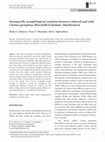
This study was designed to evaluate morphological differences between cultured and wild African c... more This study was designed to evaluate morphological differences between cultured and wild African catfish, Clarias gariepinus (Burchell). Fish samples were collected from the lower Benue River (axis in Makurdi), while cultured fish were obtained from the University of Agriculture Makurdi research farm. The results revealed significant sex-related variation in the fish from different environments. Significant differences were observed in all morphometric parameters measured and in three of the five meristic counts recorded. Discriminant analysis and cluster analysis of morphometric parameters showed a high divergence among the populations, hence the tested fish samples were grouped into respective environments by sex. The meristic count, however, overlapped broadly showing no divergence among the populations. The morphometric differences between the cultured and wild African catfish could have been linked to genetic differences or environmental factors or a combination of both factors.

This study was designed to evaluate the growth performance of Tilapia, (Oreochromis niloticus) fe... more This study was designed to evaluate the growth performance of Tilapia, (Oreochromis niloticus) fed diets with various inclusion levels of Duckweed (Lemna minor). Five isonitrogenous (20% CP) diets containing 5%, 10%, 15%, 20% and 25% of Duckweed representing diets 1 to 5 respectively were prepared. The fish were fed 5% of their body weight for 56 days. O. niloticus fingerlings with mean initial weight (MIW) of 1.45g±0.00was used for the experiment and the fingerlings were procured from a homogenous source through natural breeding. The result showed that fish fed 5% Duckweed inclusion (diet 1) gave the best value for mean weight gain (MWG = 1.92g±0.001), specific growth rate (SGR = 1.41±0.01), Food Conversion Ratio (FCR = 1.94±0.01) and Apparent Net Protein Utilization (ANPU = 57.47±1.24). Fish fed Diet 2 (10% Duckweed) however followed closely with MWG of 1.85g±0.00; FCR 2.37±0.00 and ANPU 48.34 ± 0.02. This trend of decrease however continued till Diet 5 suggesting that as Duckweed inclusion increases, MWG, SGR, PER and ANPU decreases across the five treatments while FCR increased. 5% level of inclusion of Duck weed is advised for inclusion in the Diet of O. niloticus
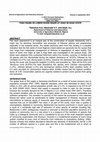
Fish stock assessment is an integral part of the conservation of aquatic biodiversity and a major... more Fish stock assessment is an integral part of the conservation of aquatic biodiversity and a major key for planning, formulation and execution of fisheries policies and programmes especially in the artisanal sector, the rapidly declining catch from fish landing is a possible indication that the fish yields of most Nigerian inland waters are generally low for causes that may range from inadequate management of fisheries to degradation of water bodies. Fish fauna of lower river Niger at Idah in Kogi State was investigated in the present study. 250 fishes were obtained from contracted fishermen within five months, covering 13 families and 26 species with the Mochokidae having the highest dominance of 18.07%, followed by the Cichlidae (16.47%) and Mormyrydae (12.05%). However the dominant fish species observed during the study was Synodontis budgetti (12.05%) and preceded by Tilpia zilli (8.43%) and Mormyrus rume (8.03%).The least abundance fish species were Clarotes macrocephalus (1.2%), Clarotes laticeps (1.2%) and Gymnachus niloticus (0.8%) least condition factor of 0.5 were recorded for Gymnarchus niloticus while Schilbe mystus had the highest condition factor of 3.99. Conservation policies are urgently needed to protect some species from going into extinction.


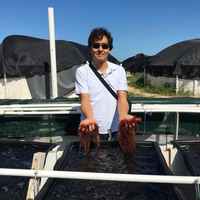


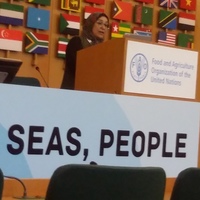


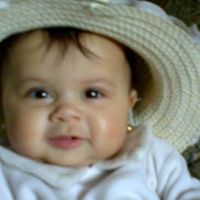

Uploads
Papers by Solomon Sola Gabriel
expensive and risky in the coastal line regions of Nigeria has been erratic and on the decline in recent years, resulting in increase in poverty and nutritional deficiency. Aquaculture production remains the best option to bridge the gap between the total fish demand and total domestic production in the face of high cost of production input and unstable government policy. This study enumerate the factors affecting aquaculture production in Nigeria with emphasis on fish seed, disease, education, production and management , feed and feeding ,government policy, veterinary care and, breeding, infrastructure and suggested way forward for profitable and sustainable aquaculture in the country.
groundwater for aquaculture is therefore threatened. Increased temperatures of surface waters can affect water quality and suitability for use in aquaculture with attendant bio-fouling and growth of thermophilic algae. Rainwater is affected by human activities and pollution as well as materials used for its collection. It is usually low in pH and will need to be buffered. The use of water from any source as well as the use of water bodies for aquaculture must be done with regular analysis of parameters since climate change is an ongoing process.
expensive and risky in the coastal line regions of Nigeria has been erratic and on the decline in recent years, resulting in increase in poverty and nutritional deficiency. Aquaculture production remains the best option to bridge the gap between the total fish demand and total domestic production in the face of high cost of production input and unstable government policy. This study enumerate the factors affecting aquaculture production in Nigeria with emphasis on fish seed, disease, education, production and management , feed and feeding ,government policy, veterinary care and, breeding, infrastructure and suggested way forward for profitable and sustainable aquaculture in the country.
groundwater for aquaculture is therefore threatened. Increased temperatures of surface waters can affect water quality and suitability for use in aquaculture with attendant bio-fouling and growth of thermophilic algae. Rainwater is affected by human activities and pollution as well as materials used for its collection. It is usually low in pH and will need to be buffered. The use of water from any source as well as the use of water bodies for aquaculture must be done with regular analysis of parameters since climate change is an ongoing process.